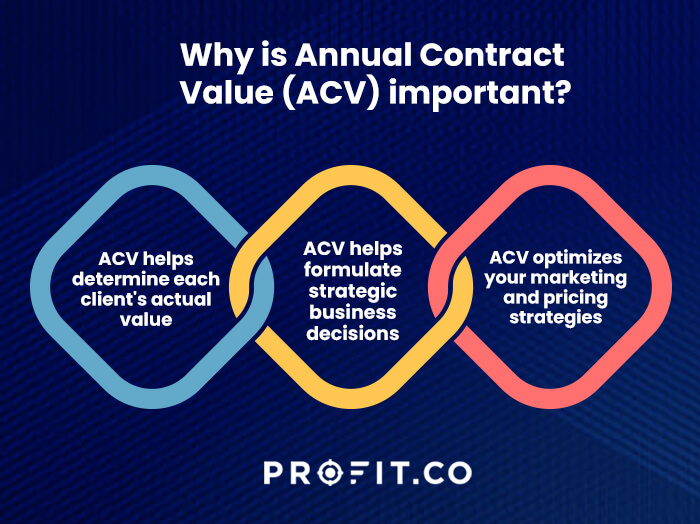Introduction
Key SaaS metrics are essential to determine the profitability of a business. They answer crucial questions such as how to boost customer acquisition. There are numerous SaaS metrics to monitor, but some are more valuable than others. Instead of tracking all the metrics, it’s best to focus on essential ones that help your business. In 2022, Gartner projects that the global SaaS market will rise to $140.6 billion. Fortunately, there are measures available to manage and measure that growth. Annual Contract Value (ACV) helps assess the health of your business.
What is the Annual Contract Value?
Annual Contract Value, also known as Annual Contract Value (ACV), is a revenue matrix that calculates the average value of client contracts over a year. ACV provides the average annual revenue you earn from each customer by normalizing the total value of your contract throughout its existence.
ACV calculations don’t include one-time or initial setup, administrative, or training expenditures. Instead, it only considers the recurring revenue produced by a single customer or account.

Definition
ACV calculates the value of your accounts regardless of whether they involve monthly, annual, or multi-year contract subscriptions. The ACV revenue matrix evaluates your data to give you a better understanding of how sales and marketing strategies are impacting your business. This approach will help you highlight strategic insights for your company. Book a free demo with our team at Profit.co to learn more about how OKR software can help you track important SaaS metrics and optimize your organization’s performance!
Therefore, you can use this metric for informed business decisions on where to best direct your efforts.
ACV is helpful when;
- Benchmarking new contracts
- Identifying valuable upsell opportunities
- Assessing sales representatives’ performances
- Allocating sales and marketing resources
Why is ACV important?
- As a strategic financial tool, ACV helps determine each client’s actual value
- ACV assists in creating and optimizing your marketing and pricing strategies
- ACV helps in the formulation of strategic business decisions
Deciding what not to do is as important as deciding what to do.
ACV formula and Calculation

How Do You Calculate the Average Contract Value
1. ACV for a single account
Customer A
Four-year contract of $1600 in contract value.
ACV = Total contract value ÷ Number of years
ACV = $1600 ÷ 4 = $400
Customer B
Three years, yearly subscription contract worth $100 monthly.
The ACV formula normalizes the contract over a year as follows;
Annual subscription = $100 x 1year (12 months) = $1200
Total contract value = $1200 x 3 years = $3600
ACV = $3600 ÷ 3 = $1200
1. ACV for multiple contracts
ACV = Total ACV of contracts ÷ Number of contracts
Method 1
This approach requires a separate calculation of the ACV for each account. Afterward, add the figures and apply the AVC formula.
Client A: ACV of $2000
Client B: ACV of $3000
Client C: ACV of $7000
Total ACV = ($2000 + $3000 + $7000) = $12000
ACV = Total ACV of contracts ÷ Number of contracts
ACV = $12000 ÷ 3 =$4000
Method 2
Batch your ACV computations if you have numerous clients with different contract terms. For example;
You have ten accounts with varying subscription terms as follows;
- Two contracts of a one-year deal, each worth $30,000.
- Six contracts for three years, each worth $60,000.
- Two contracts for five years, each worth $100,000.
Batch-calculate each contract’s ACV;
- ACV = $30,000 ÷ 1 year = $30,000 x 2 contracts = $60,000
- ACV = $60,000 ÷ 3 years = $20,000 x 6 contracts = $120,000
- ACV = $100,000 ÷ 5 years = $20,000 x 2 contracts = $40,000
Add up all the contracts ACV.
Total ACV = $60,000 + $120,000 + $40,000 = $220,000
Apply the ACV formula
ACV = $220,000 ÷ 10 = $22,000
ACV vs ARR
Annual recurring revenue (ARR) tracks annual income as well. ARR provides the total annual income generated yearly from all your subscription customers. AAR calculations include subscription upgrades, renewals, and new bookings but not trials and one-time subscriptions
See the table below for the main differences between ACV and ARR.
| ACV | ARR |
|---|---|
| Measures the revenue from just one subscription over several years | Gauges the value of all of the company’s subscriptions simultaneously |
| Occasionally includes one-time and initial contract fees | excludes initiation and one-time contract fees |
| The ACV calculation formula changes based on company needs. | The ARR formula is standard for most businesses. |
| ACV calculates the annual contract value as a normalized average payment over a year. | ARR calculates recurring revenue as the total value generated per year. |
Conclusion
Calculations can be daunting and challenging to keep track of numbers constantly. There are various tools you can use to measure performance. SaaS metrics show the success level of your current strategies and the areas that need work. Objectives and Key Results (OKRs) is a goal management framework developed for implementing strategy in the business world. The leadership of any organization has the mandate to create OKR strategies and then direct their teams in a way they will work towards the desired outcomes. OKR (Objectives and Key Results) methodology has delivered unprecedented success in bridging the strategy execution gap on numerous occasions to technology titans like Google and Intel. So onboarding an agile OKR framework to track the SaaS metric will serve to improve the productivity of any organization. Schedule a free demo to learn how Profit.co can help you focus, measure, and achieve your most important targets.

